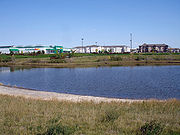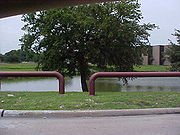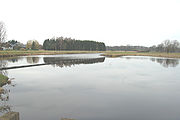
Retention basin
Encyclopedia



Stormwater
Stormwater is water that originates during precipitation events. It may also be used to apply to water that originates with snowmelt that enters the stormwater system...
runoff
Surface runoff
Surface runoff is the water flow that occurs when soil is infiltrated to full capacity and excess water from rain, meltwater, or other sources flows over the land. This is a major component of the water cycle. Runoff that occurs on surfaces before reaching a channel is also called a nonpoint source...
to prevent flood
Flood
A flood is an overflow of an expanse of water that submerges land. The EU Floods directive defines a flood as a temporary covering by water of land not normally covered by water...
ing and downstream erosion
Erosion
Erosion is when materials are removed from the surface and changed into something else. It only works by hydraulic actions and transport of solids in the natural environment, and leads to the deposition of these materials elsewhere...
, and improve water quality
Water quality
Water quality is the physical, chemical and biological characteristics of water. It is a measure of the condition of water relative to the requirements of one or more biotic species and or to any human need or purpose. It is most frequently used by reference to a set of standards against which...
in an adjacent river
River
A river is a natural watercourse, usually freshwater, flowing towards an ocean, a lake, a sea, or another river. In a few cases, a river simply flows into the ground or dries up completely before reaching another body of water. Small rivers may also be called by several other names, including...
, stream
Stream
A stream is a body of water with a current, confined within a bed and stream banks. Depending on its locale or certain characteristics, a stream may be referred to as a branch, brook, beck, burn, creek, "crick", gill , kill, lick, rill, river, syke, bayou, rivulet, streamage, wash, run or...
, lake
Lake
A lake is a body of relatively still fresh or salt water of considerable size, localized in a basin, that is surrounded by land. Lakes are inland and not part of the ocean and therefore are distinct from lagoons, and are larger and deeper than ponds. Lakes can be contrasted with rivers or streams,...
or bay
Bay
A bay is an area of water mostly surrounded by land. Bays generally have calmer waters than the surrounding sea, due to the surrounding land blocking some waves and often reducing winds. Bays also exist as an inlet in a lake or pond. A large bay may be called a gulf, a sea, a sound, or a bight...
. Sometimes called a wet pond or wet detention basin, it is an artificial lake with vegetation around the perimeter, and includes a permanent pool of water in its design.
It is distinguished from a detention basin
Detention basin
A detention basin is a stormwater management facility installed on, or adjacent to, tributaries of rivers, streams, lakes or bays that is designed to protect against flooding and, in some cases, downstream erosion by storing water for a limited period of a time. These basins are also called "dry...
, sometimes called a dry pond, which temporarily stores water after a storm, but eventually empties out at a controlled rate to a downstream water body. It also differs from an infiltration basin
Infiltration basin
An infiltration basin , is a type of best management practice that is used to manage stormwater runoff, prevent flooding and downstream erosion, and improve water quality in an adjacent river, stream, lake or bay...
which is designed to direct stormwater to groundwater
Groundwater
Groundwater is water located beneath the ground surface in soil pore spaces and in the fractures of rock formations. A unit of rock or an unconsolidated deposit is called an aquifer when it can yield a usable quantity of water. The depth at which soil pore spaces or fractures and voids in rock...
through permeable soils.
Wet ponds are frequently used for water quality improvement, groundwater recharge, flood protection, aesthetic improvement or any combination of these. Sometimes they act as a replacement for the natural absorption of a forest or other natural process that was lost when an area is developed. As such, these structures are designed to blend into neighborhoods and viewed as an amenity.
Design features
Storm water is typically channeled to a retention basin through a system of street and/or parking lotParking lot
A parking lot , also known as car lot, is a cleared area that is intended for parking vehicles. Usually, the term refers to a dedicated area that has been provided with a durable or semi-durable surface....
storm drain
Storm drain
A storm drain, storm sewer , stormwater drain or drainage well system or simply a drain or drain system is designed to drain excess rain and ground water from paved streets, parking lots, sidewalks, and roofs. Storm drains vary in design from small residential dry wells to large municipal systems...
s, and a network of drain channels or underground pipes. The basins are designed to allow relatively large flows of water to enter, but discharges to receiving waters are limited by outlet structures that function only during very large storm events.
Retention ponds are often landscaped with a variety of grass
Grass
Grasses, or more technically graminoids, are monocotyledonous, usually herbaceous plants with narrow leaves growing from the base. They include the "true grasses", of the Poaceae family, as well as the sedges and the rushes . The true grasses include cereals, bamboo and the grasses of lawns ...
es, shrub
Shrub
A shrub or bush is distinguished from a tree by its multiple stems and shorter height, usually under 5–6 m tall. A large number of plants may become either shrubs or trees, depending on the growing conditions they experience...
s and/or wetland
Wetland
A wetland is an area of land whose soil is saturated with water either permanently or seasonally. Wetlands are categorised by their characteristic vegetation, which is adapted to these unique soil conditions....
plants to provide bank stability and aesthetic benefits. Vegetation also provides water quality benefits by removing soluble nutrients through uptake. In some areas the ponds can attract nuisance types of wildlife like ducks or Canada Geese
Canada Goose
The Canada Goose is a wild goose belonging to the genus Branta, which is native to arctic and temperate regions of North America, having a black head and neck, white patches on the face, and a brownish-gray body....
, particularly where there is minimal landscaping and grasses are mowed. This reduces the ability of fox
Fox
Fox is a common name for many species of omnivorous mammals belonging to the Canidae family. Foxes are small to medium-sized canids , characterized by possessing a long narrow snout, and a bushy tail .Members of about 37 species are referred to as foxes, of which only 12 species actually belong to...
es, coyote
Coyote
The coyote , also known as the American jackal or the prairie wolf, is a species of canine found throughout North and Central America, ranging from Panama in the south, north through Mexico, the United States and Canada...
s and other predators to approach their prey unseen. Such predators tend to hide in the cattails and other tall, thick grass surrounding natural water features.
See also
- Nationwide Urban Runoff Program (NURP) – US stormwater research project
- Settling basinSettling basinA settling basin, settling pond or decant pond are devices used to treat turbidity in industrial wastewater. The basins are used to control water pollution in diverse industries such as agriculture, aquaculture, and mining....
– for treating agricultural & industrial wastewater - Stream restorationStream restorationStream restoration or river restoration, sometimes called river reclamation in the UK, describes a set of activities that help improve the environmental health of a river or stream. Improved health may be indicated by expanded habitat for diverse species and reduced stream bank erosion...
- Sustainable urban drainage systemsSustainable urban drainage systemsSustainable Drainage Systems , sometimes known as Sustainable Urban Drainage Systems , are designed to reduce the potential impact of new and existing developments with respect to surface water drainage discharges.-Background:...
- Urban runoffUrban runoffUrban runoff is surface runoff of rainwater created by urbanization. This runoff is a major source of water pollution in many parts of the United States and other urban communities worldwide.-Overview:...
- Water pollutionWater pollutionWater pollution is the contamination of water bodies . Water pollution occurs when pollutants are discharged directly or indirectly into water bodies without adequate treatment to remove harmful compounds....
- Sustainable Flood Retention Basin
- Balancing lakeBalancing lakeA balancing lake is a term used in the U.K. describing an element of an urban drainage system used to control flooding by temporarily storing flood waters...
(UK)
Other meanings
A retention basin can also be a part of a nuclear reactorNuclear reactor
A nuclear reactor is a device to initiate and control a sustained nuclear chain reaction. Most commonly they are used for generating electricity and for the propulsion of ships. Usually heat from nuclear fission is passed to a working fluid , which runs through turbines that power either ship's...
used to contain a core meltdown.
External links
- Virginia retention basin standards
- Detention vs. retention – Harris County, Texas Flood Control District
- Stormwater Ecological Enhancement Project – University of Florida
- The use of retention ponds in residential settings
- International Stormwater BMP Database – Performance Data on Urban Stormwater BMPs

